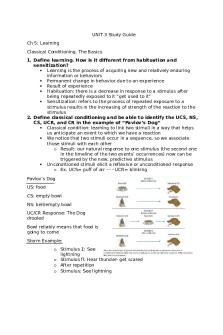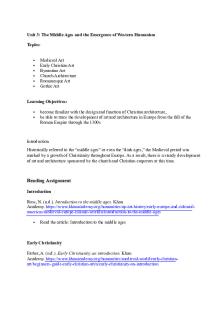Unit 3 quiz study guide with answers Bio113 PDF

| Title | Unit 3 quiz study guide with answers Bio113 |
|---|---|
| Course | Life Science for Allied Health |
| Institution | Mount Wachusett Community College |
| Pages | 5 |
| File Size | 94.1 KB |
| File Type | |
| Total Downloads | 69 |
| Total Views | 124 |
Summary
Study guide for Unit 3 Quiz. Answered to the best of my knowledge. Used to study on my Quiz and did well. Bio113...
Description
Bio 113: Life Science for Allied Health UNIT THREE STUDY GUIDE: BIOCHEMISTRY VOCABULARY:
Energy-Ability to do work Work-using force to move something Potential-energy contained in something due to position or internal state Kinetic Energy-energy of motion Metabolism-all the body’s chemical reactions Catabolism-breaks molecules down, releasing energy Anabolism-stores energy by joining molecules together Oxidation-a molecule gives up electrons and releases energy Reduction-molecule gains electrons and energy (O & R reactions occur together and are known as oxidation-reduction (redox) reactions. Organic-study of carbon-based molecules Functional groups-hydroxyl, carbonyl, carboxyl, amino, sulfhydryl, phosphate, methyl groups
Monomer-molecules made up of a series of similar or identical parts Polymer-a substance composed of molecules with large molecular mass made up of repeating structural units, or monomers, connected by covalent chemical bonds Dehydration synthesis-reaction in cells which occurs when a hydroxyl is removed from one monomer and a hydrogen is removed from on another, joining the boomers with a covalent bond and releasing water as a by product Hydrolysis-water molecules ionizes and a covalent bond is broken between monomers adding hydroxyl to one monomer and the hydrogen to the other Isomers-compounds with the same molecular formula but different structures Carbohydrates-organic molecules are synthesiszed by photosynthesis in plants grains, cereals, breads, cane sugar-types of carbo. Are monosaccharides, disaccharides, polysaccharide Monosaccharides- simple, oneunit sugars- glucose, fructose
-one sugar-composed of carbon, hydrogen and oxygen Glucose-major source of energy for the body Disaccharides-sucrose, lactosetwo monosaccharides linked together by glycosidic bonds Polysaccharides-chains of linked monosaccharide units Glycogen-storage form of glucose in the body(liver -stored in muscles) Starch-storage form of glucose in plants Cellulose-structural polysaccharides in plant cell walls. Not digestible by humans -fiber Lipids-macromolecules ( but not polymers) usually made up of only carbon, hydrogen and oxygen— Types- fatty acids, triglycerides, phospholipids, eicosanoids, steroids Fatty acid-precursor of tryglycerides, source of energy Saturated fatty acids-has as many hydrogens as it can bond to
Unsaturated fatty acidsContains double bonds and do not contain all the hydrogens that they could if they didn’t have double bonds Polyunsaturated fatty acidshave many double bonds between carbons Essential fatty acids-cannot be made in the body must be consumed Triglycerides (fats/oils) Energy storage, thermal insulation, filling space, binding organs together, cushioning organs Trans fats-unsaturated fat with trans-isomer fatty acid Phospholipids-major component of cell membranes, aid in fat digestion
Amino acid Peptide bond- bond between two amino acids Polypeptide-long chain of amino acids Denaturation-occurs when a protein loses its structure and function due to extreme heat or Ph changes Enzyme-Protiens that speed up chemical reactions in the body Substrate-whats being observed in a chemical reaction Active site-the substrate joins the enzyme at a location on the enzyme
Steroids-chemical messengers between cells
Activation energy-energy needed to get a chemical reaction started
Cholesterol-naturally produced in the liver
Cofactor-non-protien helper required to function properly
(HDL -good cholesterol prevent cardiovascular disease
Coenzyme-organic cofactors that are usually derived from vitamins
LDL)-bad cholesterol contributes to cardio
Metabolic Pathway-chain of reactions with direct enzyme
catalyzing each step. Can be turned off by altering any enzyme in the pathway. Allows cells to be efficient and not waste resources when not needed. Nucleic Acids-polymers of nucleotides Nucelotide-an organic molecule made up of a nitrogenous base, a sugar and one or more phosphate groups ATP-A nucleotide containing the nitrogenous base adenine, the sugar ribose and 3 phosphate groups. Responsible for most energy transferred in the body. Can be removed ATP to make ADP and AMP, releasing energy. DNA-makes up our genes, code for the proteins made by our cells. Double helix made up of 4 diff nucleotides RNA-three types responsible for protein production in the cells Triglycerides-main function in energy storage
REQUIRED CORE OBJECTIVES: 1. What is the significance of functional groups in organic molecules? Determines the properties of a molecule 2. Describe the formation and decomposition of organic molecules by dehydration synthesis reactions and hydrolysis reactions. In dehydration synthesis reactions, a water molecule is formed as a result of generating a covalent bond between two monomeric components in a larger polymer. In hydrolysis
reactions, a water molecule is consumed as a result of breaking the covalent bond holding together two components of a polymer. 3. For each of the four classes of macromolecules (carbs- energy storage and structure, Monosaccharides, glusoce and Fructose—— proteins- storage and structural, Amino Acids, Enzymes and some hormones——- nucleic acids-genetic information, Nucleotides, DNA and RNA ———- and lipids- Energy storage and a chemical messenger, Fatty Acids and glycerol, Oil and Cholesterol
4. Compare and contrast the three general types of carbohydrates and give examples of each. Monosaccahrides- simple, one unit sugars. Glucose, fructose and galactose. Are isomers and have same molecular formulas Disaccarides- made up of 2 monosaccharides joined together, table sugar, milk Polysaccharides- very long chains, glycogen, starch, cellulose 5. Explain the significance of glycogen and glucose in the human body. Glycogen - storage form of glucose in the body Glucose- used for energy 6. List the three major types of lipids and explain the function(s) of each. (Fatty acids, steroids, phospholipids). 7. 8. Compare and contrast saturated and unsaturated fats. Saturated Fats are solids at room temp and have a single bond while unsaturated fats are liquid at room temperature and have double bonds. They both supply energy. 9. Know the structure common to all twenty amino acids and what distinguishes one amino acid from the other. They are different because of thier R groups 10. Describe the four levels of protein structure. (possible matching?)primary-sequence of amino acids joined by peptide bonds -secondary-alpha helix or beta sheet formed by hydrogen bonding -tertiary structure-folding and coiling due to interactions among r groups -Quaternary structureassociation of two or more polypeptide changes with each other 11. Explain the relationship between shape and function of a protein. Shape determines its function and is dependent on its structure 12. Name factors that denature proteins. Changes in pH, increased temperature 13. Explain how enzymes function and why they are important in a living organism. Enzymes help speed up chemical reactions and are essential in creating chemical reactions. 14. Explain the induced fit model for enzyme function. Enzymes change shape to better bind to the substrates. 15. Know and explain factors that affect enzyme function (pH, temperature, cofactors, coenzymes, concentration)
16. Name the three components of a nucleotide Nitrogenous base, a sugar and one or more phosphate group 17. Compare and contrast DNA and RNA structure. DNA has two nucleotides chains resulting in a double helix while RNA has a single nucleotide chain. They both are nucleic acids. 18. Describe the basic structure and function of ATP. ATP is an energy molecule and is the way the body stares and releases energy
4 categories of organic macromolecules in living things -carbohydrates, lipids, proteins, nucleic acids...
Similar Free PDFs

UNIT 3 Study Guide
- 19 Pages

Unit 3 Study Guide
- 4 Pages

Quiz 3 Study Guide
- 1 Pages

DNA study Guide with Answers
- 3 Pages

Unit 3 study guide - unit test 3
- 3 Pages

Quiz with answers for Unit 6
- 8 Pages

Unit 3 Study Guide - notes
- 8 Pages

Student Study Guide Unit 3
- 13 Pages

PSY255 QUIZ 3 Study Guide
- 4 Pages

Exam 3 Study Guide (Answers)
- 5 Pages

Quiz 7 - quiz with answers
- 2 Pages

HW2+quiz+with+answers
- 3 Pages
Popular Institutions
- Tinajero National High School - Annex
- Politeknik Caltex Riau
- Yokohama City University
- SGT University
- University of Al-Qadisiyah
- Divine Word College of Vigan
- Techniek College Rotterdam
- Universidade de Santiago
- Universiti Teknologi MARA Cawangan Johor Kampus Pasir Gudang
- Poltekkes Kemenkes Yogyakarta
- Baguio City National High School
- Colegio san marcos
- preparatoria uno
- Centro de Bachillerato Tecnológico Industrial y de Servicios No. 107
- Dalian Maritime University
- Quang Trung Secondary School
- Colegio Tecnológico en Informática
- Corporación Regional de Educación Superior
- Grupo CEDVA
- Dar Al Uloom University
- Centro de Estudios Preuniversitarios de la Universidad Nacional de Ingeniería
- 上智大学
- Aakash International School, Nuna Majara
- San Felipe Neri Catholic School
- Kang Chiao International School - New Taipei City
- Misamis Occidental National High School
- Institución Educativa Escuela Normal Juan Ladrilleros
- Kolehiyo ng Pantukan
- Batanes State College
- Instituto Continental
- Sekolah Menengah Kejuruan Kesehatan Kaltara (Tarakan)
- Colegio de La Inmaculada Concepcion - Cebu



